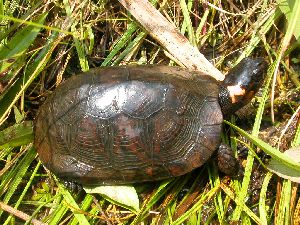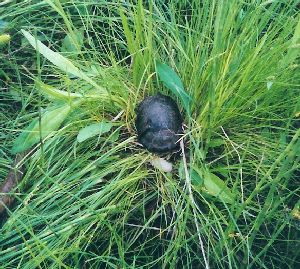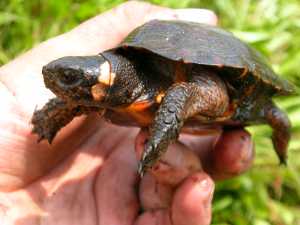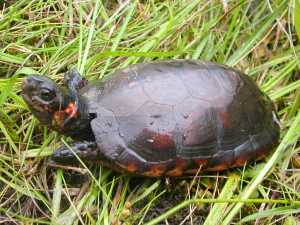Bog Turtle - November 2003 Species of the Month
|
The Bog Turtle (Clemmys muhlenbergii)
is an inhabitant of wet meadows and bogs that are mucky with organic soil
kept saturated by groundwater discharge. These palm-sized, elusive turtles
spend much of their lives hidden in the cool, soft muck, which provides
them with cover and comfort when its hot and a safe, protected place to
hibernate during the colder months.
|
|
|
Once abundant throughout New Jersey, bog turtles are
now primarily found in the remaining rural areas of New Jersey, such as
Sussex, Warren, Hunterdon and Salem counties. Intense land uses such as
large-scale agriculture, urbanization, wetland alterations and stormwater
outputs are incompatible with bog turtles and have depleted bog turtle
populations from much of the state.
|
|
| Since the 1970s biologists
have studied the life history, habitats and distribution of the bog turtle
in New Jersey. Current conservation efforts are productive and include habitat
management, population monitoring, land acquisition and landowner education.
The bog turtle was listed as an endangered species in New Jersey in 1974
and as a “threatened” species throughout the United States in
1997. It was the November Species of the Month.
The designation is part of a yearlong program to commemorate the 30th Anniversary
of the New Jersey Endangered Species Conservation Act and the formation
of DEP's Endangered and Nongame Species Program
(ENSP). |
|

Bog Turtle

Bog Turtle Nesting

Bog Turtle
|
|
Bog Turtle Habitat Preservation
Efforts are not Bogged Down
As of 2003 there are 238 individual wetlands
known to support bog turtles in New Jersey, making this state
one of the largest strongholds in the range of the bog turtle
in the eastern United States. The DEP Endangered and Nongame Species
Program is implementing a comprehensive management plan to provide
long-term conservation of the important bog turtle populations,
with the plan’s four strategies described below.
- Landowner Contacts – Since
many of the priority bog turtle sites are located on private
land, landowners are being educated about the species and the
ecological value of their habitats. State biologists walk properties
with landowners and address their questions and concerns regarding
wildlife and conservation topics.
- Acquisition – Several bog turtle
sites are located on properties slated for development. The
DEP has forged partnerships between government and private land
conservation organizations to help preserve priority bog turtle
sites. To date, six sites have been acquired and several additional
acquisitions are being negotiated.
- Computer Mapping
– The DEP’s GIS-based Landscape Project generates
electronic maps that identify critical bog turtle habitats and
their equally important connecting land corridors. These maps
are guiding the DEP’s regulatory reviews for land development,
open space preservation, and water resource protection.
- Habitat Management – Most
bog turtle sites are in need of management or restoration efforts.
One significant threat is the encroachment of invasive vegetation,
such as natural, introduced or exotic plants, bushes and trees
that naturally colonize open meadows and fill in bog turtle
habitat. One effective restoration technique used by DEP is
the use of domestic livestock to browse and graze invasive vegetation.
Goats, sheep and cows are leased annually from local farmers
and are currently being used at 15 sites in the state’s
more rural counties.
In an effort initiated 1998, the DEP has introduced
a particular beetle species, a natural grazer of the invasive
European wetland plant the purple loosestrife, at 26 bog turtle
sites. Working cooperatively with the New Jersey Department of
Agriculture’s Beneficial Insect Lab, which raises and releases
the beetles, these populations are being monitored to see if they
will have significant impact on the reduction of the purple loosestrife
population at these sites.
Since 1987, when the New Jersey Freshwater
Wetlands Protection Act was enacted, many large wetland areas
have been protected from development. In addition, large wetland
tracts have been acquired as public open space, which all collectively
help to support a substantial number of priority bog turtle populations.
|
|
Bog Turtles– Facts of Interest
- Bog turtles are best known for the orange patch
behind the ear membrane on either side of the head. The scale-like layers
of the upper shell are dark and may have yellow or reddish centers.
The shell underneath is also dark with a yellow or reddish center. The
limbs are brown and may be mottled with yellow, orange or red patches.
- They are tiny creatures with a shell length of
about 3” – 4” at adulthood. They can live for as long
as 20 – 30 years and weigh about four ounces. Male bog turtles
have a larger head, thicker tail, longer front claws and a wider shell
than females.
- The preferred habitat of bog turtles is usually
a well-drained bog or wet pasture with a water depth that rarely exceeds
four inches in depth. This type of habitat can be impacted negatively
by vegetative succession, or positively, by beavers or by controlled
grazing.
- Bog turtles are active from spring through fall
and hibernate during winter. Throughout summer they remain concealed
in dense wetland vegetation and bask occasionally in the sun. To escape
high summer heat, avoid danger or to hibernate, they burrow into the
mucky bottom of the surrounding bog. As a result, bog turtles can
spend up to half of their lives buried in mud.
- These turtles eat plants (seeds, berries, young
cattail shoots, duckweed), animals (insect larvae, snails, millipedes
and beetles) and even carrion (dead animals), and will dine while
in or out of the water. Their favorite and most abundant food resource
found in their habitat is the common slug.
|
| Ways You Can Help |
|
- If you find a bog turtle outdoors do not keep it
as a pet – leave it be. Because of their small size, coloration
and rarity, bog turtles are prized by collectors. However, it is a violation
of state and federal laws to catch, possess, sell, trade or import bog
turtles.
 When
driving you may happen upon a bog turtle crossing the road. Assist the
turtle by picking it up and carrying it across the road in the direction
that it was heading, placing it at a safe distance from the roadside.
Road systems have fragmented the waterways and wetlands areas that are
key habitat requirements for these turtles. Also be sure to report any
sightings of these turtles to DEP’s Endangered and Nongame Species
Program. When
driving you may happen upon a bog turtle crossing the road. Assist the
turtle by picking it up and carrying it across the road in the direction
that it was heading, placing it at a safe distance from the roadside.
Road systems have fragmented the waterways and wetlands areas that are
key habitat requirements for these turtles. Also be sure to report any
sightings of these turtles to DEP’s Endangered and Nongame Species
Program.
- Persons interested in reptiles and amphibians who
also enjoy being outdoors can become a volunteer with the Herp
Atlas Project. Volunteers assist with conducting a quantitative
survey of all reptile and amphibian species throughout the state. To
learn more, visit www.nj.gov/dep/fgw/ensp/herpatl.htm
for details.
- Do you enjoy learning about New Jersey wildlife?
Being outdoors? Interacting with the public? Assisting with meaningful
volunteer initiatives? If so, join the Wildlife
Conservation Corps, the state's largest natural resource management
volunteer group. Volunteer opportunities are diverse and include lending
assistance with trout stocking; operating check stations; maintaining
shooting ranges; and instructing the public. Adults interested in public
speaking are also invited to join the Corp's Endangered
and Nongame Species Program's Speakers Bureau. The bureau provides
speakers to organizations interested in learning more about New Jersey's
threatened and endangered species.
|
|
|
Order a
Conserve Wildlife special interest license plate for your vehicle. It's
tax-deductible, with 80% of the payment benefiting New Jersey's Endangered
and Nongame Species Program. |
|
Want to learn new information quickly about New Jersey
wildlife? The Division of Fish and Wildlife offers eight E-mail "mailing
list" choices to the public. Visit the E-mail
List Subscription Page to learn more about this free service and how
to sign up.
|
|
|
| Additional
Sources of Information |
|
|